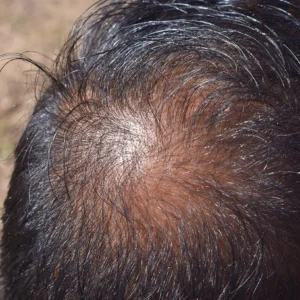Male Pattern Baldness (MPB), also known as male androgenetic alopecia, is a prevalent condition affecting approximately 80% of men at some point in their lives. It is characterized by non-scarring, progressive hair loss, typically manifesting in a distinct pattern. This phenomenon is not just a cosmetic concern but also has psychological and social implications. Recent research has shed light on the intricate mechanisms underlying MPB, revealing a fascinating interplay between genetics, hormonal influences, and developmental biology, leading to follicular miniaturization.
THE PROCESS OF HAIR FOLLICLE MINIATURIZATION
Hair follicle miniaturization is a gradual process that occurs in individuals with androgenetic alopecia, or male and female pattern hair loss. It begins with the interaction between genetics and hormones, particularly dihydrotestosterone (DHT), a byproduct of testosterone metabolism. In genetically predisposed individuals, hair follicles in certain areas of the scalp, typically at the temples, crown, and frontal scalp, become increasingly sensitive to DHT. When DHT binds to receptors on hair follicle cells, it disrupts the normal growth cycle, leading to a shortened anagen (growth) phase and a prolonged telogen (resting) phase. Over time, affected hair follicles produce progressively finer, shorter, and lighter-colored hairs, a process known as miniaturization. Eventually, miniaturized hair follicles may become inactive and cease producing visible hairs altogether, resulting in noticeable hair thinning and balding. Hair follicle miniaturization is a hallmark feature of androgenetic alopecia and underscores the importance of addressing hormonal factors in hair loss treatment strategies.
GENETIC AND HORMONAL UNDERPINNINGS
Follicular miniaturization, a key process in the progression of androgenetic alopecia (AGA), is intricately linked to hormonal underpinnings, particularly the influence of dihydrotestosterone (DHT). DHT, a potent derivative of testosterone, plays a central role in AGA by binding to androgen receptors on susceptible hair follicles. This binding triggers a cascade of molecular events within the follicle, including the shortening of the anagen (growth) phase and the prolongation of the telogen (resting) phase. Consequently, affected hair follicles undergo a process of miniaturization, wherein they produce progressively thinner, shorter, and weaker hairs with each successive growth cycle. This phenomenon ultimately leads to a reduction in hair density and visible scalp balding characteristic of AGA.
The hormonal underpinnings of follicular miniaturization in AGA extend beyond DHT, involving a complex interplay of androgens, follicular sensitivity, and genetic predisposition. Androgens, including testosterone and DHT, are essential for normal hair growth but can exert deleterious effects on susceptible follicles in individuals predisposed to AGA. Genetic factors determine the sensitivity of hair follicles to androgens, with variations in genes encoding androgen receptors and enzymes involved in androgen metabolism contributing to individual susceptibility to AGA. Moreover, hormonal changes associated with aging, such as fluctuations in androgen levels and alterations in hormone receptor expression, further exacerbate follicular miniaturization and hair loss progression in susceptible individuals. Understanding the hormonal underpinnings of follicular miniaturization is crucial for developing targeted therapies that modulate androgen activity and disrupt the pathological processes driving AGA.
A NEW PERSPECTIVE
One of the most intriguing aspects of recent research is the hypothesis that differences in the developmental origins of scalp regions contribute to MPHL. The frontal scalp, typically affected by MPB, may have a different embryonic origin (neural crest ectoderm) compared to the more resilient occipital scalp (mesoderm). This variance could explain why certain scalp regions are more susceptible to androgen-induced follicle miniaturization.
A REFLECTION OF ACCELERATED AGING?
An interesting proposition made in the study is that MPB might represent a form of localized accelerated aging. This is based on the observation that the frequent cycling and changes in hair follicles in MPB mimic those seen in the natural aging process of hair. Understanding this could potentially broaden the scope of therapeutic targets, including interventions aimed at the aging process itself.
CONCLUSION
This comprehensive exploration into the causes of MPB underscores the importance of considering scalp location in hair follicular miniaturization research. The varying responses and characteristics of hair follicles, depending on their location and origin, can significantly impact the effectiveness and appropriateness of treatment strategies. As research continues to unravel the complexities of MPB, it paves the way for more targeted and effective treatments, offering hope to millions affected by this condition.

